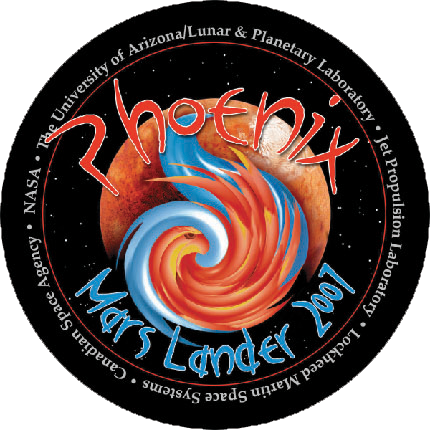
May 28, 2008 (Ls 77.5 My 29) to Oct 28, 2008 (Ls 148 MY 29

Above is shown the measured 532 nanometer backscatter intensity, in the form of measured voltages, from Phoenix Lander LIDAR pulses values obtained during sol 109 of the mission. Published results (Whiteway et al, 2009, SCIENCE, July 3rd, Volume 325) for the same times illustrate the derivation of atmospheric backscatter coefficient derived from these voltage measurements.
All Phoenix-measured analog backscatter voltages, at 532 nm and 1064 nm, for mission sols 1-150 are available. Digital counts of backscattered 532 nm photons are also available. The LIDAR data are packaged in to mission sol folders within which the analog voltage measurement files and the digital photon count files are available.

Mars Phoenix LIDAR mounted on the deck of the lander; image shows a simulated LIDAR 532 nm laser pulse
All Phoenix-measured analog backscatter voltages, at 532 nm and 1064 nm, for mission sols 1-150 are available. Digital counts of backscattered 532 nm photons are also available. The LIDAR data are packaged in to mission sol folders within which the analog voltage measurement files and the digital photon count files are available.

Mars Phoenix LIDAR mounted on the deck of the lander; image shows a simulated LIDAR 532 nm laser pulse
Light Detection and Ranging (LIDAR)
Throughout the course of Phoenix surface operations, LIDAR measured dust and ice distribution in the martian atmosphere. The instrument provided information about time-dependent structure of the planetary boundary layer. The Phoenix LIDAR laser is a passive Q-switched Nd:YAG laser with the dual wavelengths of 1064 nm and 532 nm. It operates at 100 Hz with a pulse width of 10 ns. The scattered light is received by two detectors that operate (green and IR) and the green signal is collected in both analog and photon counting modes. The Canadian Space Agency was responsible for the development of the MET and LIDAR instruments with the support of Optech Inc. of Toronto for specific development of the LIDAR.
http://phoenix.lpl.arizona.edu/science05.php
http://phoenix.lpl.arizona.edu/science05.php
Useful Mission Documents
Mission Description
Spacecraft Description
Software Interface Specification (SIS) - Description of the instrument and data structures
Calibration Document - Description of the calibration methods
Spacecraft Description
Software Interface Specification (SIS) - Description of the instrument and data structures
Calibration Document - Description of the calibration methods
Archive Bundle Collections
Document - Directory containing the Document Collection, including references to refereed journals using this instrument.
Raw Data - Directory containing the EDR data files for sols 1-150.
Data Set Description (pdf)
Reduced Data - Directory containing the RDR data files for sols 1-150.
Data Set Description (pdf)
For the Experienced User
Complete Bundle - Zip file containing the entire LIDAR Bundle.
LIDAR Bundle Root - The root directory for the entire LIDAR instrument Bundle.
Raw Data - Directory containing the EDR data files for sols 1-150.
Data Set Description (pdf)
Reduced Data - Directory containing the RDR data files for sols 1-150.
Data Set Description (pdf)
For the Experienced User
Complete Bundle - Zip file containing the entire LIDAR Bundle.
LIDAR Bundle Root - The root directory for the entire LIDAR instrument Bundle.
Selecting Data - This will allow you to access a time-ordered list of observations and to select products based on physical parameters of your choice. Completion of your product list results in an order returned below
Receiving Data
Citing Data Sets for Publications
CITATION_DESC = Dickinson, C.D., PHX METEOROLOGICAL DATA V1.0, NASA Planetary Data System, 2008.
Other Useful Products for Interpreting the Data
References - Representative Publications using the data
Other Potential Relevant Data - Data that may be relevant from missions other than PHX
Archived PHX SPICE ancillary data providing observation geometry (positions, orientations, instrument pointing, time conversions, etc.) are available from the PDS NAIF Node.
 PDS: The Planetary Atmospheres Node
PDS: The Planetary Atmospheres Node

